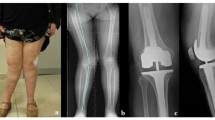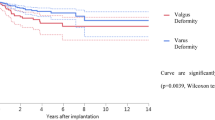Abstract
Purpose
Knee instability is one of the most common indications for having to undergo revision total knee arthroplasty (RTKA) and can be prevented with adequate implant selection and good surgical technique. Varus-valgus constrained implants (VVC) are indicated for cases of RTKA with absent ligament function in order to provide the necessary stability. While mobile-bearing articulations are thought to decrease the risk of aseptic loosening in comparison to their fixed-bearing counterparts, there is limited data on their outcomes. The purpose of our study is to present the clinical and radiological outcomes for patients undergoing an RTKA procedure with the mobile-bearing VVC implant.
Methods
Between January 2008 to January 2018, 93 patients underwent RTKA with the use of varus-valgus mobile-bearing (VVCMB) prosthesis. The main indications for RTKA were instability 38.7% (n = 36), aseptic loosening 31.2% (n = 29), infection in 26.9% (n = 25), and other 3.3%. The mean follow-up time was 56 months. Clinical outcomes were assessed by knee society scores, range of motion, and rate of re-operation.
Results
The mean knee society score increased significantly from 65.52 pre-operatively to 89.65 post-operatively (p < 0.001). The five year cumulative incidence of re-operation in our study was 7.53% (n = 7). Our study reported no cases of aseptic loosening or mobile-bearing spin-out. The number of flexion contractures decreased from n = 23 (24.7%) pre-operatively to n = 11 (11.8%) post-operatively (p < 0.05).
Conclusion
The VVC mobile-bearing prosthesis demonstrated good clinical outcomes and mid-term survivorship in patients undergoing RTKA. Additional follow-up is required in the long term.


Similar content being viewed by others
References
Kurtz SM, Ong KL, Schmier J et al (2007) Future clinical and economic impact of revision total hip and knee arthroplasty. J Bone Joint Surg Am 89(Suppl 3):144–151. https://doi.org/10.2106/JBJS.G.00587
Losina E, Thornhill TS, Rome BN et al (2012) The dramatic increase in total knee replacement utilization rates in the United States cannot be fully explained by growth in population size and the obesity epidemic. J Bone Joint Surg Am 94:201–207. https://doi.org/10.2106/JBJS.J.01958
Abdelaal MS, Restrepo C, Sharkey PF (2020) Global perspectives on arthroplasty of hip and knee joints. Orthop Clin North Am 51:169–176. https://doi.org/10.1016/j.ocl.2019.11.003
Callaghan JJ, O’rourke MR, Saleh KJ (2004) Why knees fail: lessons learned. J Arthroplasty 19:31–34. https://doi.org/10.1016/j.arth.2004.02.015
Rodriguez-Merchan EC (2011) Instability following total knee arthroplasty. HSS J 7:273–278. https://doi.org/10.1007/s11420-011-9217-0
Reina N, Salib CG, Pagnano MW et al (2020) Varus-valgus constrained implants with a mobile-bearing articulation: results of 367 revision total knee arthroplasties. J Arthroplasty 35:1060–1063. https://doi.org/10.1016/j.arth.2019.11.023
Engh GA, Ammeen DJ (1999) Bone loss with revision total knee arthroplasty: defect classification and alternatives for reconstruction. Instr Course Lect 48:167–175
Nelson CL, Gioe TJ, Cheng EY, Thompson RC (2003) Implant selection in revision total knee arthroplasty. J Bone Jt Surg - Ser A 85:43–51. https://doi.org/10.2106/00004623-200300001-00009
Mabry TM, Hanssen AD (2007) The role of stems and augments for bone loss in revision knee arthroplasty. J Arthroplasty 22:56–60. https://doi.org/10.1016/j.arth.2007.02.008
Capella M, Dolfin M, Saccia F (2016) Mobile bearing and fixed bearing total knee arthroplasty. Ann. Transl, Med
Insall JN, Dorr LD, Scott RD, Scott WN (1989) Rationale of the Knee Society clinical rating system. Clin Orthop Relat Res:13–14
Sculco TP (2006) The role of constraint in total knee arthoplasty. J Arthroplasty 21:54–56. https://doi.org/10.1016/j.arth.2006.02.166
Parratte S, Pagnano MW (2008) Instability after total knee arthroplasty. J Bone Joint Surg Am 90:184–194
Kim RH, Martin JR, Dennis DA et al (2017) Midterm clinical and radiographic results of mobile-bearing revision total knee arthroplasty. J Arthroplasty 32:1930–1934. https://doi.org/10.1016/j.arth.2017.01.014
Limberg AK, Tibbo ME, Pagnano MW et al (2020) Varus-valgus constraint in 416 revision total knee arthroplasties with cemented stems provides a reliable reconstruction with a low subsequent revision rate at early to mid-term review. Bone Joint J 102-B:458–462. https://doi.org/10.1302/0301-620X.102B4.BJJ-2019-0719.R2
Patel JV, Masonis JL, Guerin J et al (2004) The fate of augments to treat-type-2 bone defects in revision knee arthroplasty. J Bone Jt Surg - Ser B. https://doi.org/10.1302/0301-620X.86B2.13564
Adravanti P, Vasta S (2017) Varus-valgus constrained implants in total knee arthroplasty: indications and technique. Acta Biomed 88:112–117. 10.23750/abm.v88i2-S.6521
Kim YH, Park JW, Kim JS, Oh HK (2015) Long-term clinical outcomes and survivorship of revision total knee arthroplasty with use of a constrained condylar knee prosthesis. J Arthroplasty 30:1804–1809. https://doi.org/10.1016/j.arth.2015.04.019
Wilke BK, Wagner ER, Trousdale RT (2014) Long-term survival of semi-constrained total knee arthroplasty for revision surgery. J Arthroplasty 29:1005–1008. https://doi.org/10.1016/j.arth.2013.10.025
Lee JK, Lee S, Kim D et al (2013) Revision total knee arthroplasty with varus-valgus constrained prosthesis versus posterior stabilized prosthesis. Knee Surgery, Sport Traumatol Arthrosc 21:620–628. https://doi.org/10.1007/s00167-012-1998-2
Author information
Authors and Affiliations
Corresponding author
Ethics declarations
Ethics approval
This study was approved by the institutional review board.
Conflicts of interest
None of the authors in this study have any conflict of interest.
Additional information
Publisher’s note
Springer Nature remains neutral with regard to jurisdictional claims in published maps and institutional affiliations.
Rights and permissions
About this article
Cite this article
Gurel, R., Morgan, S., Elbaz, E. et al. Good clinical and radiological outcomes of the varus-valgus constrained mobile-bearing implant in revision total knee arthroplasty. International Orthopaedics (SICOT) 45, 1199–1204 (2021). https://doi.org/10.1007/s00264-021-05003-7
Received:
Accepted:
Published:
Issue Date:
DOI: https://doi.org/10.1007/s00264-021-05003-7




